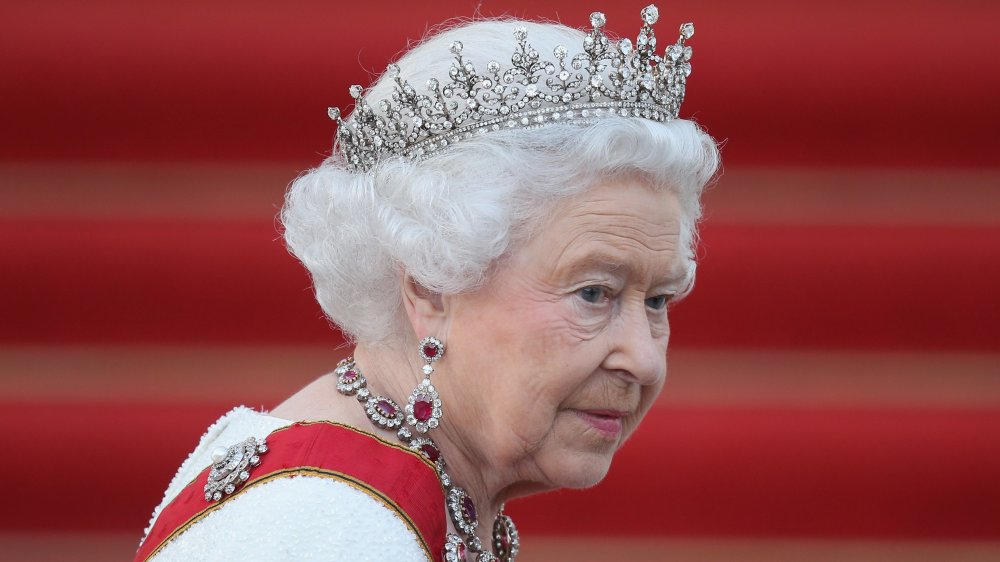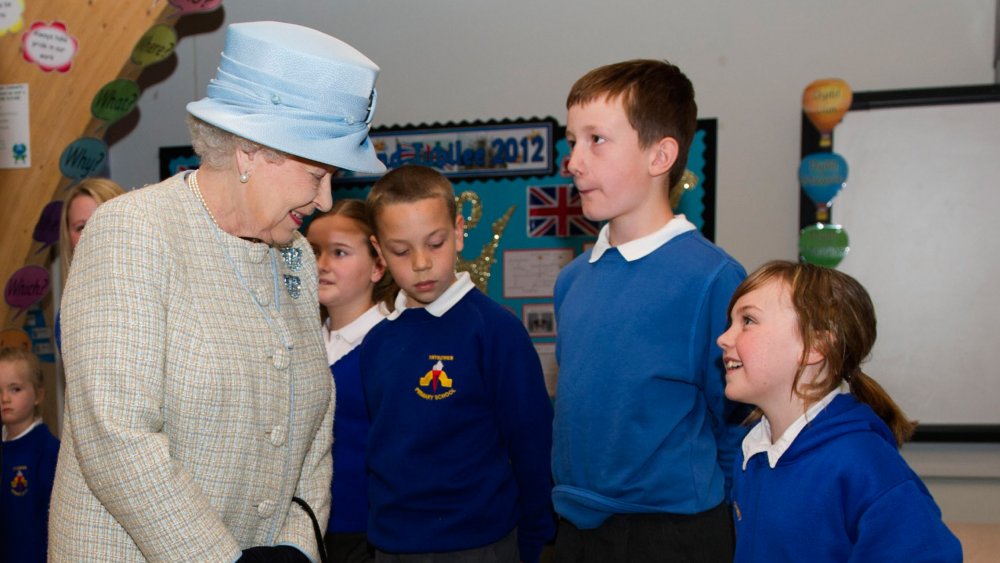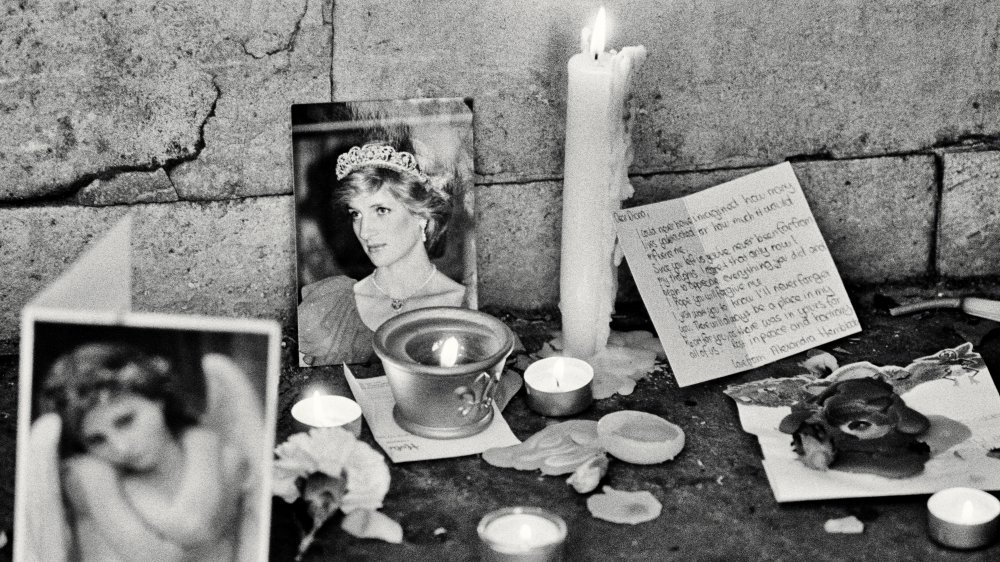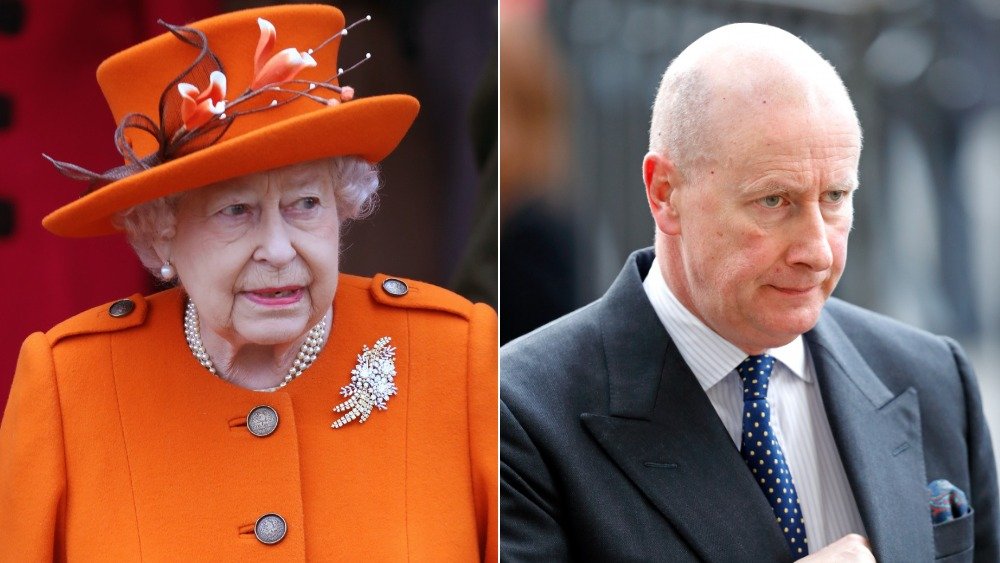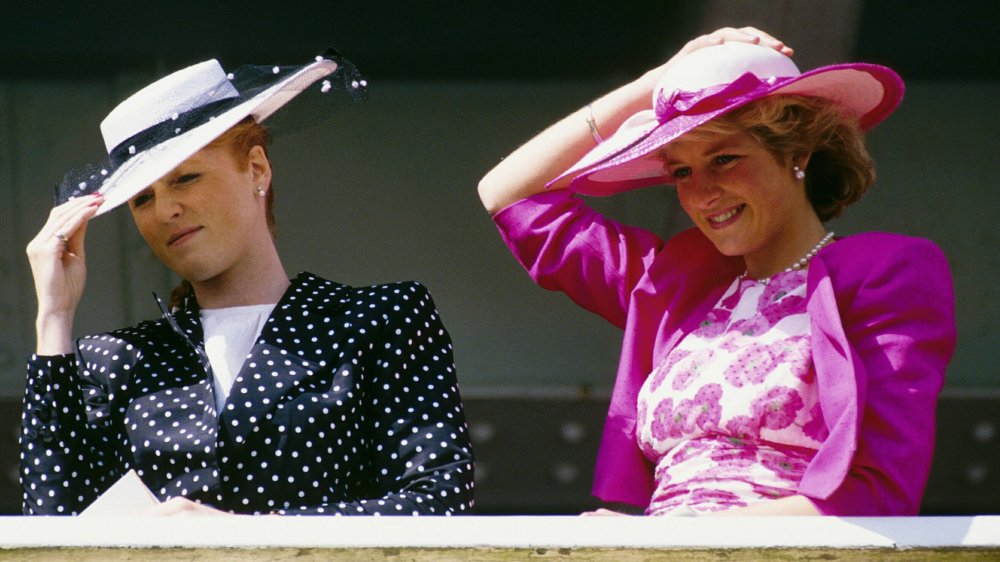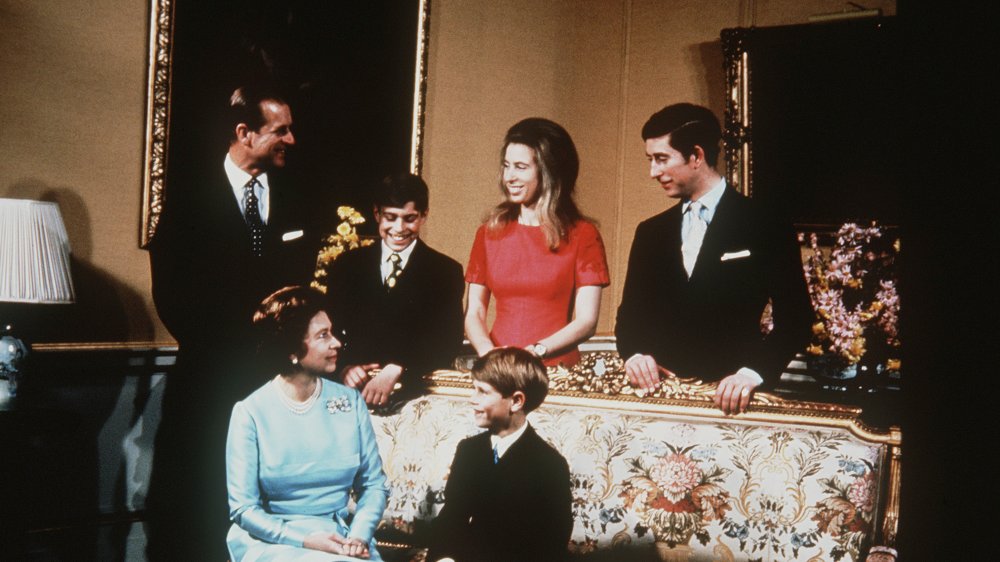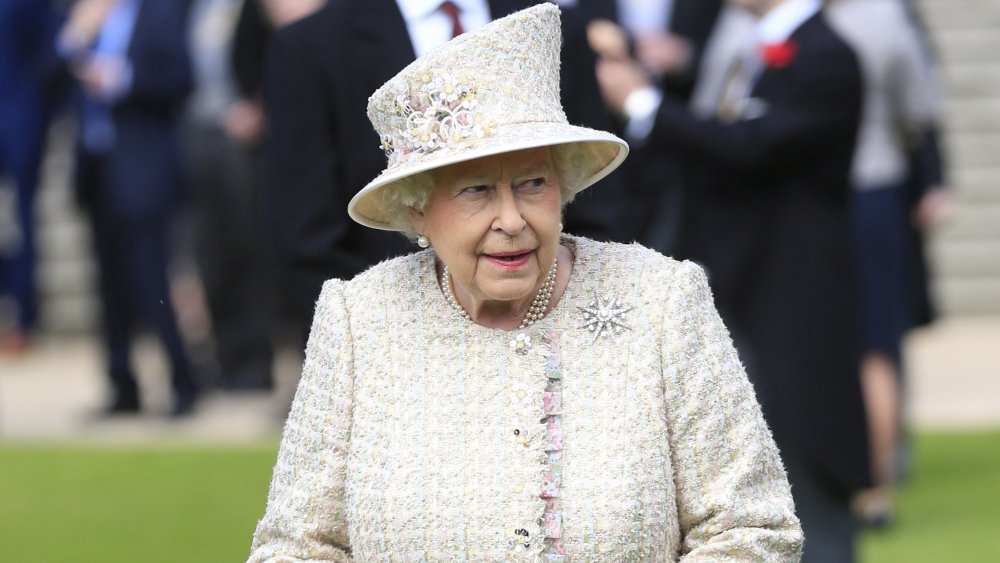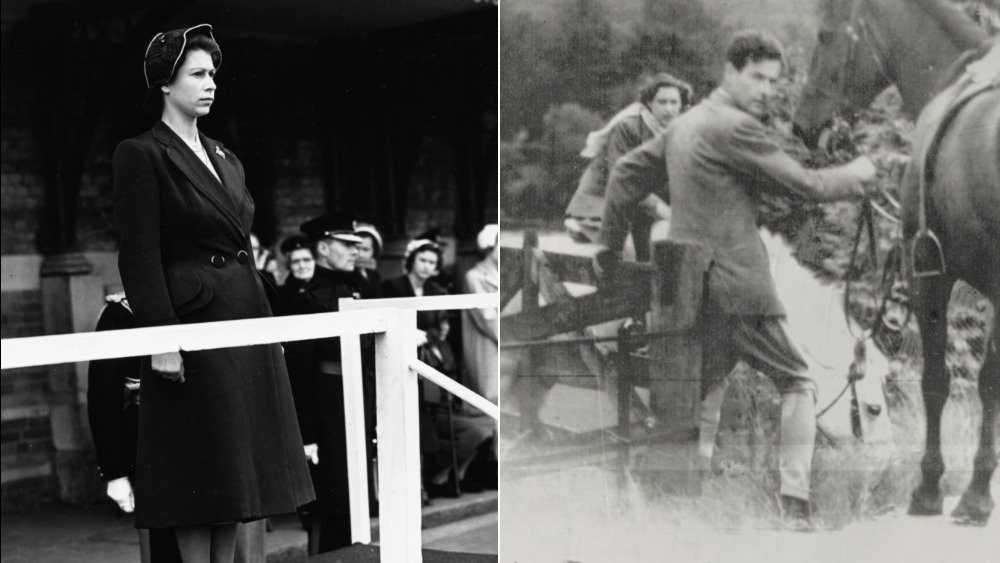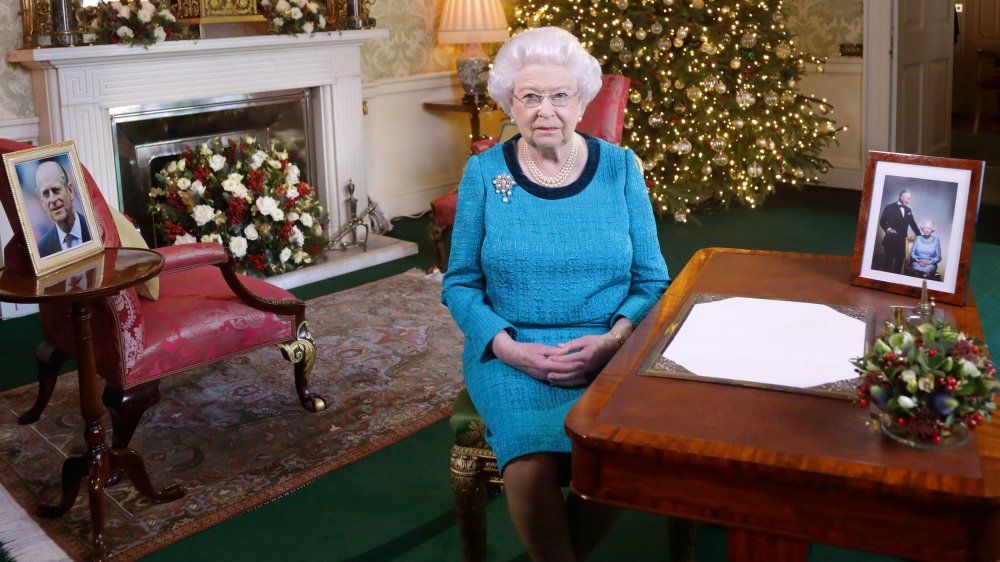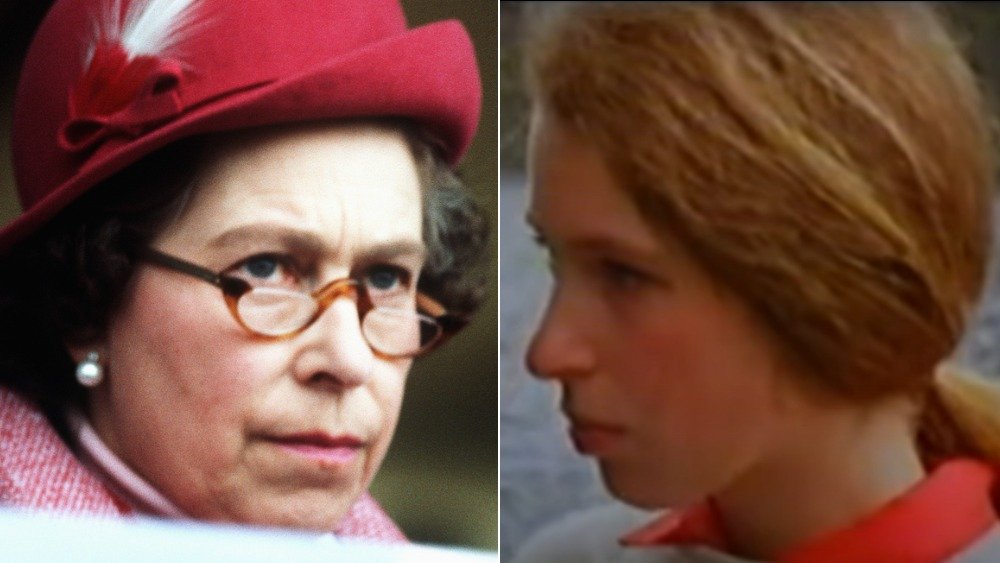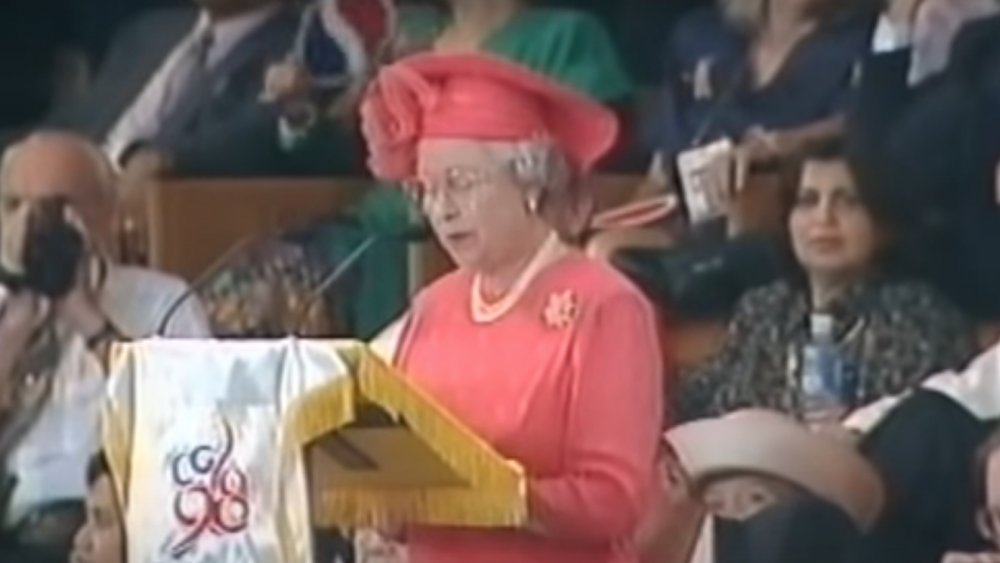The Biggest Mistakes The Queen Has Made
Queen Elizabeth II has a variety of responsibilities. Throughout her record-breaking reign as the British monarch, she's served as the head of the Church of England, hosted the country's prime ministers to dispense advice, and represented her people at public events and ceremonies. Not to mention that the British people often look to her for guidance in times of crisis and celebration.
Privately, of course, the queen is the head of her royal family. She was a daughter, sister, wife, and mother before she was crowned the Queen of England at her 1953 coronation — and under all of the hats she wears (pun intended), she's also human ... which means that even the queen has made mistakes. While her majesty is known to not express political opinions or show emotion in public very often so as to not rattle onlookers, Queen Elizabeth has admitted to committing one or two wrongs. But there are definitely plenty of naysayers willing to point out her worst missteps — and some of these are not quite as funny as Princess Diana fumbling Prince Charles' name while saying her vows or Prince Harry's slight mishandling of Duchess Meghan Markle's veil.
Let's take a closer look at Queen Elizabeth's biggest mistakes.
Queen Elizabeth's delayed response to the Aberfan mining disaster is her 'biggest regret'
On Oct. 21, 1966, a spoil tip of mining waste collapsed on the Pantglas Junior School in the Welsh village of Aberfan, killing over 140 people — 116 of them children (via BBC News). In times of tragedy, the British people look to Queen Elizabeth II, but she didn't visit the town until eight days after the event. Her husband, Prince Phillip, and brother-in-law Lord Snowden were the first royals to visit — and it's been widely reported that her own delayed response has remained the queen's "biggest regret." At least, she supposedly told her former private secretary, Lord Charteris, as much, according to the South Wales Echo.
However, there was a reason for her initial decision. Per Sally Bedell Smith's biography, Elizabeth the Queen, she reportedly told advisers encouraging her to go, "People will be looking after me. Perhaps they'll miss some poor child that might have been found under the wreckage." Her eventual visit, which was portrayed during Season 3 of The Crown, marked "one of the few occasions in which she shed tears in public," former royal press office employee Sir William Heseltine once said (via Town & Country). She later visited Aberfan four more times.
In 2002, a survivor told the South Wales Echo, "If the Queen does regret not coming here straight away, I think that is misplaced. When she did arrive she was visibly upset and the people of Aberfan appreciated her being here."
The queen's unpopular lack of action after Princess Diana's death
The death of a loved one is a tragic and traumatic experience — and when a princess dies, it becomes a public travesty. After Princess Diana's untimely passing in August 1997, Queen Elizabeth II took five days before she addressed the public and shared her "overwhelming sadness" over the loss ... temporarily leaving British citizens to mourn without their royal leader.
While those close to the queen believe she regretted this decision, she had a pretty good reason for the delay. "Her first thoughts were for her grandchildren, and for once she put family before duty," Penny Junor wrote in The Firm (via Express). So, Queen Elizabeth remained at the side of young Prince William and Prince Harry, mourning the People's Princess' death at the family's vacation home at Balmoral Castle in Scotland. This made it impossible for her to "feel the raw emotion" pouring out throughout the country, especially near Buckingham Palace.
"She thought that the answer to the mass hysteria was to stay calm and to keep on doing what the family had always done, safe in tradition," Junor continued. "It was a mistake, however, to let the nation believe that neither she nor any other member of the royal family cared about the tragedy that had pole-axed the nation." Still, we can't necessarily blame the queen for wanting to just be a supportive grandmother at the time.
A senior member of Queen Elizabeth's staff was let go at a crucial time
Queen Elizabeth II will rarely admit to mistakes ... so the British press is happy to point them out. In 2020, Royal Central's Charlie Proctor claimed that her "biggest mistake of the decade" was losing her most trusted adviser, Private Secretary Sir Christopher Geidt, in July 2017.
Geidt apparently had a reputation for telling the royals what they needed to hear, whether they liked it or not, but left his decade-long post around when Prince Philip retired from royal duties — meaning the queen lost two opinions she valued at once. While Geidt initially announced he'd decided to step down on his own, The Times later reported that he was "forced out" by Prince Charles following a disagreement over having more say in matters in preparation for taking over the throne as king. In what's been called a "power struggle," Geidt supposedly didn't survive the row once Prince Andrew took his brother's side.
The queen reportedly agreed to his supposed firing "to avoid conflict," per BBC News. Geidt denied this report, while the Royal Households simply stated in part, "The Prince of Wales and the entire royal family are committed to supporting the Queen in whatever way they can at Her Majesty's request." However, with tensions running high amid Prince Andrew's ongoing scandals and Prince Harry and Meghan Markle stepping down as senior royals, Proctor claims the queen has appeared "weak" ever since, writing, "It is as if she cannot control her family."
The queen stripped Princess Diana and Sarah Ferguson of their royal titles
Divorce may as well be a four-letter word in the royal family. Queen Elizabeth II's uncle, King Edward VIII, infamously abdicated the throne in 1936, after he met, fell in love, and planned to marry American socialite Wallis Simpson, who was a divorcée.
By the time Prince Charles and Princess Diana finalized their divorce in 1996, it was still considered taboo, but not such a detrimental scandal as to hinder the prince's place in line to the throne. Instead, it was Princess Diana who lost the "Her Royal Highness" part of her title. While the queen makes the final call on all title decisions, it's been rumored that Prince Charles himself had insisted that his ex-wife lose the title. In fact, those close to the queen suspect she may have regrets.
When Prince Harry and Meghan Markle stepped down as senior members of the royal family, it was reported that Queen Elizabeth struggled with the choice to strip them of the HRH part of their titles due to her past regret. "I have a feeling she won't strip [Harry and Meghan] of the titles because they did that with both [Prince Andrew's ex-wife] Fergie and Diana," royal author Phil Dampier claimed on the Nigel Farage Show. "I think in hindsight that was seen as a mistake because that caused resentment amongst both of them." As of April 2020, the Sussexes no longer use their respective HRH titles.
Was Queen Elizabeth emotionally unavailable for her older children?
Perhaps Queen Elizabeth II put Princes William and Harry first at the darkest time in their lives because she supposedly failed to do the same for her own children when they were younger — particularly Prince Charles and Princess Anne. With the soon-to-be-queen spending most of her time either with her naval officer husband Prince Phillip or preparing for her royal reign at home and abroad, the two were mostly raised by nannies.
Charles once described his mother as "not indifferent so much as detached" to Jonathan Dimbleby, the author of his authorized biography (via Vanity Fair). Anne, however, is famously less sensitive than her older brother, which might explain her different take on the queen's "caring" mothering style. "We as children may have not been too demanding in the sense that we understand what the limitations were in time," she said in the docuseries, Queen and Country (via BBC News), "and the responsibilities placed on her as monarch in the things she had to do and the travels she had to make."
However, when Queen Elizabeth had Prince Andrew 10 years after Anne's birth, "evidence suggests she became warmer and more flexible as time went by," historian Robert Lacy told Town & Country, spending more time with her children. As for her youngest son, Prince Edward, it's rumored that he's his parents' "favorite child," with wife Countess Sophie becoming "like a daughter" to the queen, per a royal aide cited by the Daily Mail.
How the queen's insomnia reportedly almost got her seriously injured
A deep dive into Queen Elizabeth II's mistakes is a reminder that, despite the royal pomp and circumstance, she's human just like the rest of us. That means dealing with some of life's more mundane problems, like being unable to sleep and walking around the grounds of the palace to fight it. But one night, her insomnia allegedly almost got her seriously injured.
In 2017, an ex-guard claimed to The Times that he once saw someone he believed to be an intruder while patrolling Buckingham Palace's grounds at around 3 a.m. Thankfully realizing it was just the queen, he recalled to the publication shouting, "Bloody hell, Your Majesty, I nearly shot you." Yikes. In response, she reportedly said (via People), "That's quite all right. Next time I'll ring through beforehand so you don't have to shoot me."
While the Palace never confirmed the report and the date of the supposed incident remains unknown, we have to admit that this sounds like a pretty Queen Elizabeth thing to say. Perhaps she should keep her nighttime walks indoors from now on for maximum safety.
Have Queen Elizabeth's standards for romantic partners been too strict?
Queen Elizabeth II has had to uphold England's marriage rules because of her place in the monarchy. She's always a sister, a mother, and a grandmother simultaneously, so her decisions have caused some friction in the family.
Princess Margaret and Peter Townsend (pictured, right) were engaged to be married in 1952. According to BBC News, the queen first had to give her blessing, but was pressured by the Church of England and Prime Minister Winston Churchill to not allow her sister to marry a divorced man, all under the Royal Marriages Act of 1772. Advised to wait two years until she turned 25 and had more rights under the act, the princess and Townsend were separated when Townsend, an equerry to the queen, was sent to a post in Brussels. Ultimately, they chose not to marry, and no one will ever know what would've happened if Elizabeth had put her role of sister before her duties as queen.
The queen later had a similar problem as mother to Prince Charles and putting his happiness above her image. Biographer Tom Bower wrote in his book, Rebel Prince (via the Daily Mail), that in the summer of 1998 — one year after Princess Diana's death — Prince Charles asked his mother to finally accept longtime mistress Camilla Parker Bowles' presence in his life. The two eventually married, however the queen apparently initially refused, reportedly saying she wanted "nothing to do" with "that wicked woman."
The queen has a reputation for being cold with the public
Throughout her reign, Queen Elizabeth II hasn't been able to publicly express many opinions, as saying too much about anything could alienate her country men and women. The Christmas speech, then, is the rare chance for Britain's monarch to get personal with the people. Her grandfather, King George V, was the first to deliver this holiday speech in 1932, and after giving her own first Christmas speech 20 years later, 1957 saw the broadcast move from radio to television.
She may make mistakes, but she's also capable of recognizing and fixing them when she wants to — and this included addressing her chilly reputation head-on. "I very much hope that this new medium will make my Christmas message more personal and direct," the queen said during her first Christmas speech for broadcast television. "It is inevitable that I should seem a rather remote figure to many of you. A successor to the Kings and Queens of history; someone whose face may be familiar in newspapers and films but who never really touches your personal lives." She continued, "But now at least for a few minutes, I welcome you to the peace of my own home."
This move onto people's TV screens may have been inevitable, but it also helped humanize Queen Elizabeth in the eyes of her people. The queen's Christmas message is now a beloved royal tradition worldwide.
The film that may have started the insatiable royal obsession
The British tabloid press has a reputation for being aggressive when it comes to royal coverage, and one of the biggest reasons for this is perhaps the public's insatiable appetite for personal details about the royal family. While Queen Elizabeth II is characteristically aloof, opening the door to her home in the 1969 BBC documentary, Royal Family, may have been a mistake.
Cameras were welcomed into life at Buckingham Palace and beyond as filming began in June 1968 and lasted for 75 days, according to Town & Country. The outlet called the film "a triumph" with viewers, noting that "the public devoured it." However, Princess Anne, for one, later made her distaste for the project known in the Elizabeth at 90 documentary. "I always thought it was a rotten idea," she said. "The attention that had been brought on mum ever since mum was a child, you just didn't want anymore. The last thing you needed was greater access ... I don't remember enjoying any part of that."
Was this next step to modernize the monarchy and endear the royals to the public the one step that exacerbated this frenzied — and sometimes dangerous — media obsession? There's no way to know for sure, but we doubt there will be another royal film that's quite as intimate anytime soon.
Even the queen isn't immune to a fashion faux pas
There's no question that Queen Elizabeth II loves a hat. In an excerpt from her book, The Other Side of the Coin: The Queen, the Dresser and the Wardrobe (via Marie Claire), the queen's dresser, Angela Kelly, told an amusing story of a hat situation gone wrong.
The queen, donning a "vibrant deep coral" dress, was on tour in Malaysia when Kelly realized that the "matching hat" that was previously planned for her to wear while closing the Commonwealth Games in Kuala Lumpur simply wouldn't work. "With a commanding shell-like brim and a very large flower on the reverse, it was certainly an interesting and beautifully made piece," Kelly wrote. "But I had a gut feeling that it would not complement the outfit or enhance Her Majesty's features."
Kelly's quick solution was to have Queen Elizabeth wear the hat backward, but the boss wasn't quite sold, leading the dresser to have the queen ask her husband, Prince Philip, his preference. "Before long, Her Majesty called me back. She had consulted His Royal Highness and, after an amusing conversation, in which I imagine The Duke didn't hold back, the Queen had decided to wear the hat the wrong way around, as I had suggested," Kelly concluded. A fashion disaster was avoided, but a fashion faux pas was committed nonetheless.

